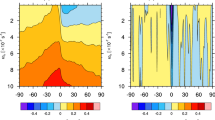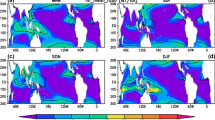Abstract
Based on the daily turbulent heat fluxes and related meteorological variables datasets (1985–2006) from Objectively Analyzed air-sea Fluxes (OAFlux) Project of Woods Hole Oceanographic Institution (WHOI), characteristics of low-frequency oscillation intensity of air-sea turbulent heat fluxes over the northwest Pacific are analyzed by linear perturbation method and correlation analysis. It can be concluded that: 1) the distribution of low-frequency oscillation intensity of latent heat flux (LHF) over the northwest Pacific is mainly affected by that of low-frequency oscillation intensity of anomalous air-sea humidity gradient (Δq′) as well as mean air-sea humidity gradient (\( \overline {\Delta q} \)), while the distribution of low-frequency oscillation intensity of sensible heat flux (SHF) is mainly affected by that of low-frequency oscillation intensity of anomalous air-sea temperature gradient (ΔT′). 2) The low-frequency oscillation of turbulent heat fluxes over the northwest Pacific is the strongest in winter and the weakest in summer. And the seasonal transition of low-frequency oscillation intensity of LHF is jointly influenced by those of low-frequency oscillation intensity of Δq′, low-frequency oscillation intensity of anomalous wind speed (U′), \( \overline {\Delta q} \) and mean wind speed (Ū), while the seasonal transition of low-frequency oscillation intensity of SHF is mainly influenced by those of low-frequency oscillation intensity of ΔT′ and Ū. 3) Over the tropical west Pacific and sea areas north of 20°N, the low-frequency oscillation of LHF (SHF) is mainly influenced by atmospheric variables q a ′ (T a ′) and U′, indicating an oceanic response to overlying atmospheric forcing. In contrast, over the tropical eastern and central Pacific south of 20°N, q s ′ (T s ′) also greatly influences the low-frequency oscillation of LHF (SHF).
Similar content being viewed by others
References
Liu J, Curry J A. Variability of the tropical and subtropical ocean surface latent heat flux during 1989–2000. Geophys Res Lett, 2006, 33: L05706, doi: 10.1029/2005GL024809
Yu L. Global variations in oceanic evaporation (1958–2005): The role of the changing wind speed. J Clim, 2007, 20: 5376–5390
Yu L, Weller R A. Objectively analyzed air-sea heat fluxes for the global ice-free oceans (1981–2005). Bull Amer Meteorol Soc, 2007, 88: 527–539
Liu W T, Katsaros K B, Businger J A. Bulk parameterization of air-sea exchanges of heat and water vapor including the molecular constraints at the interface. J Atmos Sci, 1979, 36: 1722–1735
Fairall C W, Hare J E, Grachev A A, et al. Bulk parameterization of air-sea fluxes: Updates and verification for the COARE algorithm. J Clim, 2003, 16: 571–591
Yu L, Jin X, Weller R A. Annual, seasonal, and interannual variability of air-sea heat fluxes in the Indian Ocean. J Clim, 2007, 20: 3190–3209
Yu L, Weller R A, Sun B. Improving latent and sensible heat flux estimates for the Atlantic Ocean (1988–99) by a synthesis approach. J Clim, 2004, 17: 373–393
Cayan D R. Latent snd sensible heat flux anomalies over the northern Oceans: The connection to monthly atmospheric circulation. J Clim, 1992, 5: 354–369
Cayan D R. Variability of latent and sensible heat fluxes estimated using bulk formulate. Atmos-Ocean, 1992, 30(1): 1–42
Cayan D R. Latent and sensible heat flux anomalies over the northern Oceans: Driving the sea surface temperature. J Phys Oceanogr, 1992, 22: 859–881
Tanimoto Y, Nakamura H, Kagimoto T, et al. An active role of extratropical sea surface temperature anomalies in determining anomalous turbulent heat flux. J Geophys Res, 2003, 108: 3304–3315
Li C Y. The recent advances in the study of the intraseasonal oscillation of the atmosphere (in chinese). Prog Nat Sci, 2004, 14(7): 734–741
Alexander M A, Scott J D. Surface flux variability over the north Pacific and north Atlantic Oceans. J Clim, 1997, 10: 2963–2978
Zhang G J, Mcphaden M J. The relationship between sea surface temperature and latent heat flux in the equatorial Pacific. J Clim, 1995, 8: 589–605
Pegion K, Kirtman B P. The impact of air-sea interactions on the simulation of tropical intraseasonal variability. J Clim, 2008, doi: 10.1175/2008JCLI2180.1
Ren B H, Huang R H. 30–60-day oscillations of convection and circulation associated with the thermal state of the western Pacific warm pool during boreal summer. Adv Atmos Sci, 2003, 20(5): 123–135
Li C Y. Low-frequency Oscillation in the Atmosphere (in Chinese). Beijing: China Meteorological Press, 1993. 76–78
Gutzler D S, Madden R A. Seasonal variation in the spatial structure of intraseasonal tropical wind fluctuations. J Atmos Sci, 1989, 46(5): 641–660
Hendon H H, Glick J. Intraseasonal air-sea interacyion in the tropical India and Pacific Oceans. J Clim, 1998, 11: 1685–1702
Shinoda T, Hendon H H, Glick, et al. Intraseasonal variability of surface fluxes and sea surface temperature in the tropical western Pacific and Indian Oceans. J Clim, 1997, 10: 647–661
Author information
Authors and Affiliations
Corresponding author
Additional information
Supported by National Natural Science Foundation of China (Grant No. 40675028) and National Basic Research Program of China (Grant No. 2006CB403600)
Rights and permissions
About this article
Cite this article
Li, G., Ren, B., Zheng, J. et al. Characteristics of low-frequency oscillation intensity of air-sea turbulent heat fluxes over the northwest Pacific. Sci. China Ser. D-Earth Sci. 52, 1137–1151 (2009). https://doi.org/10.1007/s11430-009-0103-2
Received:
Accepted:
Published:
Issue Date:
DOI: https://doi.org/10.1007/s11430-009-0103-2




